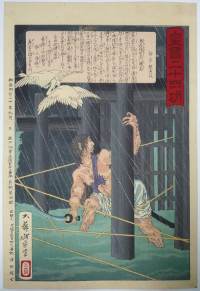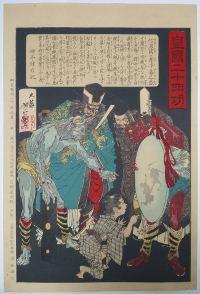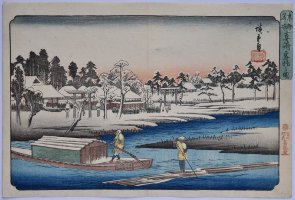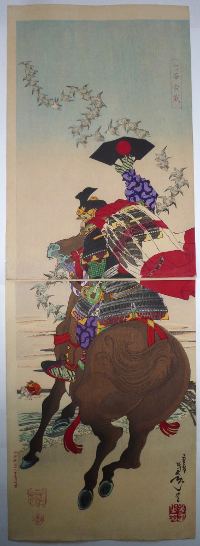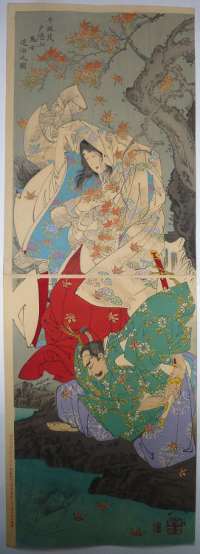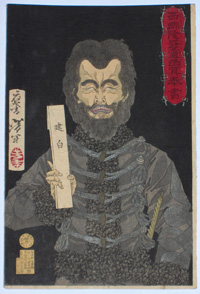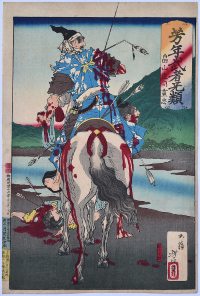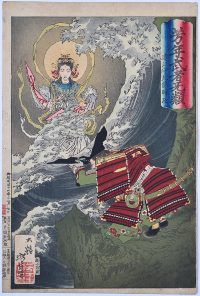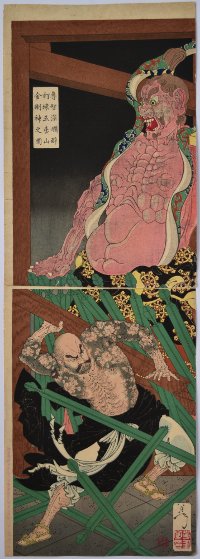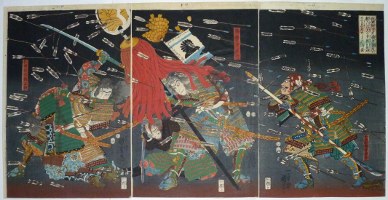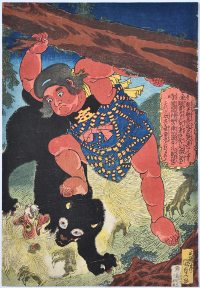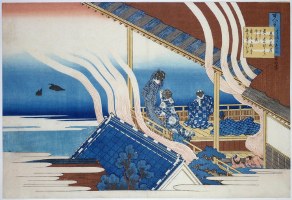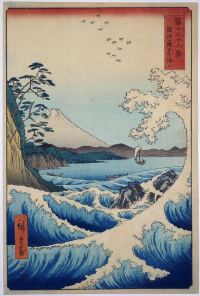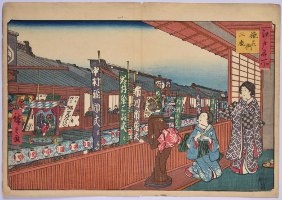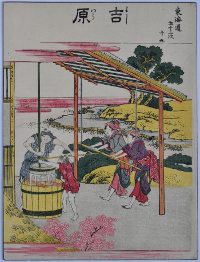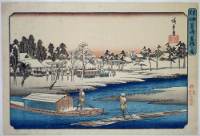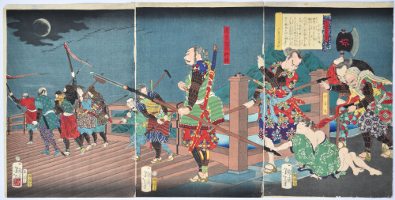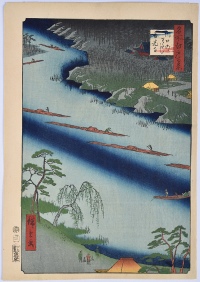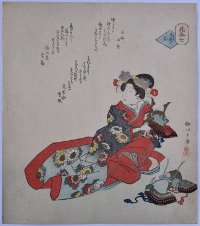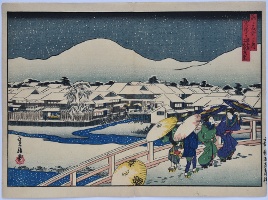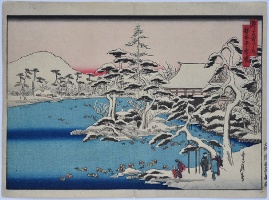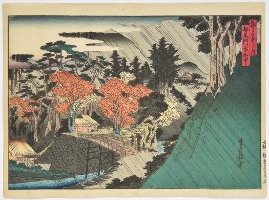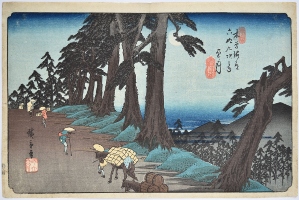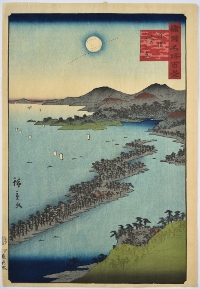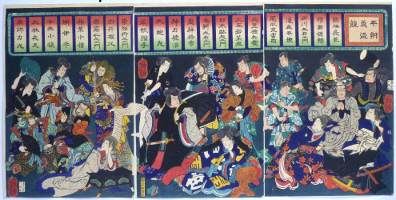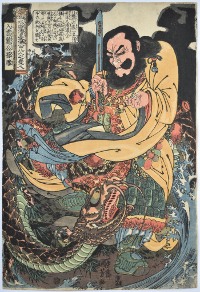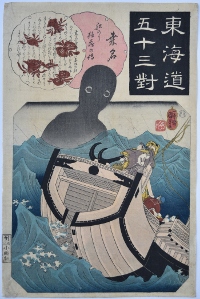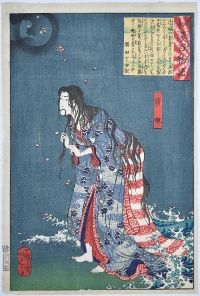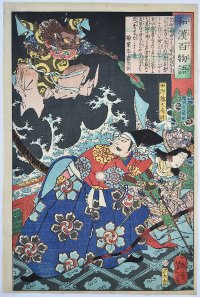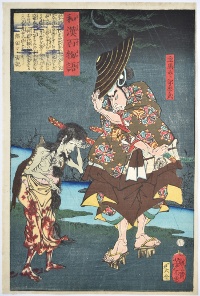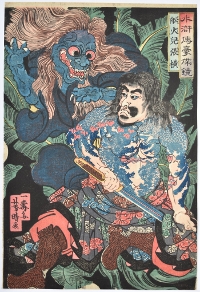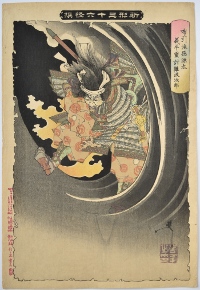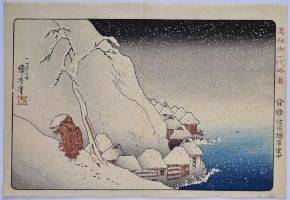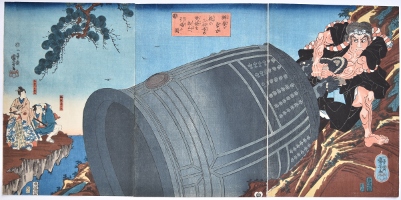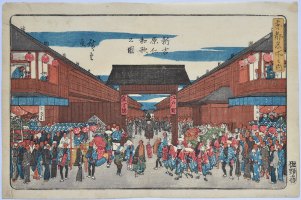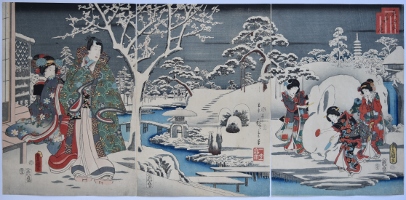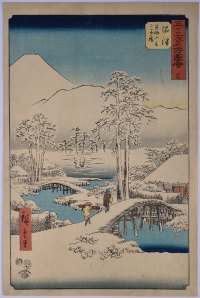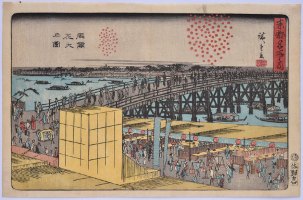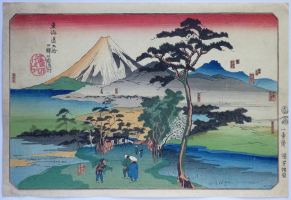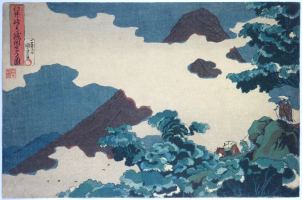Tsukioka YOSHITOSHI (1839-1892)
Click here to view image full size.
Torii Suheemon Katsutaka escaping the castle of Okudaira Nobumasa, which is being attacked by Takeda Katsuyori, in order get help from Tokugawa Ieyasu. From the set Kokoku nijushiko, “The Twenty-four Accomplishments in Imperial Japan.” Published by Tsuda Genshichi, 1881-87 (this being 1887). This is the first edition. It was republished by Matsuki Heikichi with altered signatures and other changes and inferior printing.
Very fine impression, colour and condition. Superb gradation on the piers with gofun added to the sumi. Signed Taiso Yoshitoshi ga.
Status: Sold
Tsukioka YOSHITOSHI (1839-1892)
Click here to view image full size.
Zennojo, the filial son from Shinano Province, dreams of his father’s crimes and successfully prays for his recovery from illness. From the set Kokoku nijushiko, “The Twenty-four Accomplishments in Imperial Japan.” Published by Tsuda Genshichi, 1881-87 (this being 1887). This is the first edition. It was republished by Matsuki Heikichi with altered signatures and other changes and inferior printing.
Very fine impression, colour and condition. Superb gradation and burnishing. Signed Taiso Yoshitoshi ga.
Status: Sold
Ichiryusai HIROSHIGE (1797-1858)
Click here to view image full size.
Masaki yukibare no zu, “Clear Weather After Snow at Masaki” from a Toto Meisho, “Famous Sights of the Eastern Capital” set published by Kikakudo (Sanoki), the seal in red in right margin c 1832-35. There is confusion over how many prints belong to this series: The original set of twenty-one prints seems to have been extended to fifty-five in c 1839-42. The temple, under a deep layer of snow, is shown on the far shore. In the foreground two figures in yellow straw coats navigate the river.
Very fine impression. Fine colour. Later editions have the black seal of Sanoki in right margin. Very slight centre fold and two backed pinholes; trimmed just on the black title slip on right, otherwise fine condition. Signed Hiroshige ga.
Status: Sold
Tsukioka YOSHITOSHI (1839-1892)
Click here to view image full size.
A vertical diptych showing Taira no Atsumori and Kumagai Naozane at the battle of Ichinotani in 1184. The story relates how Naozane cuts off the head of Atsumori but is overwhelmed by remorse because he looked so much like his son. Published by Matsui, Meiji 18, 1885.
Superb impression. Very fine colour and condition with ample room for joining. Untrimmed. (An essential with this set as the publishing information is often on the left margin.) The first edition (indeed, this may be the earliest state of the first edition). Signed Oju Yoshitoshi ga.
Status: Sold
Tsukioka YOSHITOSHI (1839-1892)
Click here to view image full size.
A vertical diptych showing Taira no Koremochi about to kill the female demon whose reflection he sees in a stream on Mount Togakushi in Shinano. The episode follows an excursion to view the autumn maples. He encounters a party of girls who invite him to join them to only become intoxicated and fall asleep. He is aroused by terrifying sounds emanating from the devil. The No play Momijigari, “Maple Picnic” is based on this story. Published by Matsui, Meiji 20, 1887.
Superb impression. Very fine colour and condition with ample room for joining. Untrimmed. (An essential with this set as the publishing information is often on the left margin.) The first edition. Signed Oju Yoshitoshi ga.
Status: Sold
Tsukioka YOSHITOSHI (1832 – 1892)
Click here to view image full size.
Saigo Takamori yumei hosho. Shows the ghost of Marshall Takamori ( 1827 -1877 ) holding a petition. Best known as the leader of the Satsuma rebellion, which was finally quashed at Kagoshima on Sept. 24th 1877. Saigo was wounded in the leg and his faithful retainer, Beppu Shinsuke, put an end to his life. A popular figure with a statue being erected in his honour in 1899 at the entrance to Ueno Park in Tokyo, and his son being made a Marquis in 1902. This print, published by Funazu Chujiro, was issued just under a year after he died in 7/1878. Exceptionally rare: One other ( trimmed ) impression illustrated in Beauty & Violence, Havilland Press, 1992, no. 37, p. 124. Interestingly, the print has a price of two sen, five rin marked on it.
Fine impression and colour. The ornate brocade printed in silver. Trimmed close on two sides and minor marks, otherwise good condition. Signed Oju “By special request” Yoshitoshi.
Status: Sold
Tsukioka YOSHITOSHI (1839-1892)
Click here to view image full size.
Hatakeyama Shoji Shigetada wounded by soldiers of his Lord Hojo Tokimasa. One of the best designs from a fine set: Yoshitoshi musha burui, “Yoshitoshi’s Courageous Warriors” published by Kobayashi Tetsujiro, 1883. This is the first edition with two red seals left margin, complete date with day, month and year in left margin and three-colour cartouche. Subsequent editions were printed with only two-colour cartouche and then just one colour. It was also reprinted by Tsunajima Kamekichi in 1886.
Fine impression and colour. Slight browning, otherwise very good condition. Signed Taiso Yoshitoshi ga.
Status: Sold
Tsukioka YOSHITOSHI (1839-1892)
Click here to view image full size.
Hojo Tokimasa praying to a goddess in the sea. One of the best designs from a fine set: Yoshitoshi musha burui, “Yoshitoshi’s Courageous Warriors” published by Kobayashi Tetsujiro, 1883. This is the first edition with two red seals left margin, complete date with day, month and year in left margin and (on this design) a two–colour cartouche. Subsequent editions were printed with only one colour. It was also reprinted by Tsunajima Kamekichi in 1886.
Fine impression and colour. Burnishing and mica added. Slight browning, otherwise very good condition. Signed Taiso Yoshitoshi ga.
Status: Sold
Tsukioka YOSHITOSHI (1839-1892)
Click here to view image full size.
Lu Ta ( Lu Chi Shen ) demolishing the gate of the temple of the Five-Crested Mountain. A Chinese captain, he accidentally killed a man and to escape death he became a priest at the temple. The abbot cut his hair and renamed him Lu Chi Shen, “Lu of Deep Wisdom.” However, quickly disregarding priestly vows, he became violent again and drank heavily. Staggering back one night he shattered the temple gate fighting the huge wooden guardian figures. The abbot dismissed him and he reappears as one of the 108 heroes of the Suikoden. Published by Matsui 1887.
Very fine impression of the earliest state of the first edition with blind printing and burnishing. This design was reprinted by Hasegawa with seal in upper left margin “Reproduction not permitted” and lacking date. Also, the lovely pigment used to colour the torso of the guardian figure ( which oxidizes ) is replaced with an inferior colour . There are also intermediate printings between first and Hasegawa version. Fine colour. Some discolouration on the reverse not affecting the front, otherwise fine condition with left margin intact. On thick hosho: These vertical designs must have the left border uncut as it often contains publication information. Signed Yoshitoshi.
Status: Sold
Utagawa Kuniyoshi (1797-1861)
Click here to view image full size.
A triptych Shijo-nawate nite Nanke no yeiyu taiteki wo. The last stand of the Kusunoki at Shijo-nawate under a hail of arrows in 1348. Right to left: Wada Shinbochi (Genshu), Kusunoki Masatsura, and Masatomo. Their blue demeaner indicates their imminent demise. Published 1857 by So-To (Sagamiya Tokichi). This forms a 6-sheet composition showing Masayuki, Koshiro Hyogo, and Noda Shiro. Robinson T346.
Fine impression and colour. Imperceptible fold on last sheet and slight discolouration in margins, otherwise very good condition. Full size. Signed Ichiyusai Kuniyoshi ga.
Status: Sold
Utagawa KUNISADA (1786-1864)
Click here to view image full size.
Kaido-maru (Kintoki) with his forest companion, a bear-cub, attacking a giant white monkey. The chubby Kintoki is always shown red-hued and wielding a giant axe. In this case he heaves a tree above his head. Published by Moritaya Hanzo, c 1827. Rare.
Very good impression. Fine colour. Slightly trimmed, otherwise very good condition. Signed Gototei Kunisada ga.
Status: Sold
Katsushika HOKUSAI (1760-1849)
Click here to view image full size.
A poem by Fujiwara no Yoshitaka (954-974) from Hyakunin isshu uba ga etoki, the “Hundred Poems Explained by the Wet Nurse.” Published by Eijudo and Iseri, c 1835-6. Although obviously intended to be a set of 100 prints, only 27 are known plus drawings for others. The poet speaks of a trivial life prior to meeting his lover. Two women and their companions relax after a bath admiring the view across water. Steam rises from the bath and two cormorants are seen on the left. A languid scene and one of Hokusai’s most beautiful designs.
Fine impression. Very good colour. Two states are known: the printers quickly discovered that the red seal at left was not easily discernible and cut the block to correct this. This is the first state but the seal can hardly be seen except on the reverse. Signed Zen Hokusai.
Status: Sold
Ichiryusai HIROSHIGE (1797-1858)
Click here to view image full size.
Suruga Satta no kaijo, “The Sea at Satta, Suruga Province” from Fuji sanjurokkei, “The Thirty-Six Views of Fuji.” The best design from the set published by Koeido (Tsutaya Kichizo), 4/1858. A huge wave breaks on the right releasing a flock of chidori. These birds were supposed to originate from the spume of these waves. Originally travellers on the Tokaido had to traverse the base of the cliff, to the left. However in 1655 a pass was cut in the cliff above. Fuji rises above the bay of Kiyomi. A very popular print.
Fine impression and colour. One or two very minor marks, otherwise very good condition. Signed Hiroshige ga.
Status: Sold
Ichiryusai HIROSHIGE (1797-1858)
Click here to view image full size.
The Sanza Theatre, Saruwaka-cho showing women on the balcony of a tea-house overlooking the street from an oban set Edo Meisho of approx. 45 prints published by Yamada-ya, 1853 – 1858, half being published in 1853. This design published 1858.
Fine impression and colour. Slight centre fold, otherwise good condition. Signed Hiroshige ga.
Status: Sold
Katsushika HOKUSAI (1760-1849)
Click here to view image full size.
Yoshiwara Station from a chuban Fifty-three Stations of the Tokaido. The set of 55 prints published by Iseya Rihei, c 1806. Unsigned but the original wrapper evidently had Hokusai’s signature. Two women, a man and boy press grapes.
Fine impression. Extremely fine colour. One small repaired wormhole near edge, otherwise fine condition.
Status: Sold
Ichiryusai HIROSHIGE (1797-1858)
Click here to view image full size.
Masaki yukibare no zu, “Clear Weather After Snow at Masaki” from a Toto Meisho, “Famous Sights of the Eastern Capital” set published by Kikakudo (Sanoki), the seal in red in right margin c 1832-35. There is confusion over how many prints belong to this series: The original set of twenty-one prints seems to have been extended to fifty-five in c 1839-42. The temple, under a deep layer of snow, is shown on the far shore. In the foreground two figures in yellow straw coats navigate the river. This is the best example of this design I have seen since the impression in my Catalogue 7, 1971, no 12.
Very fine impression and colour. Later editions have the black seal of Sanoki in right margin. Fine condition. Signed Hiroshige ga.
Status: Sold
Tsukioka YOSHITOSHI (1839-1892)
Click here to view image full size.
A triptych showing Ushiwakamaru (the young Minamoto Yoshitsune) holding the spear of Ise Saburo Yoshimori as he and his compatriots pass over Yahagi Bridge. From a set of triptychs Bidan musha hakkei, “Eight Views from Fine Tales of Warriors.” This being Descending Geese at Yahagi Bridge. Published 2/1868 by Kinseido. In fact this is based on an earlier version of this subject designed by Utagawa Yoshitsuya in 1861.
Very good impression, colour and condition. Signed Ikkaisai Yoshitoshi hitsu.
Status: Sold
Ichiryusai HIROSHIGE (1797-1858)
Click here to view image full size.
Kawaguchi no watashi Zenkoji, “Ferryboats to Zenkoji Temple at Kawaguchi” from Meisho Edo hyakkei, the “One Hundred Views of Edo.” The set published between 1856 and 1858 (this being 1857) by Uoya Eikichi. This fine example of a first edition with the extra large margins has never been in an album.
Superb impression of the first edition with beautiful bokashi and mica. Very fine colour and condition. Signed Hiroshige ga.
Status: Sold
Yanagawa SHIGENOBU II (active c 1824-1860)
Click here to view image full size.
A surimono: Sono shichi – Nushi aru hana, “The Flower with an Owner.” Round 7 from a series Hana-awase, “A Flower Competition.” Usually a poetry competition to produce the best poems using different flowers, although in this instance the flowers are actually familiar terms incorporating the word “flower.” A princess holding a helmet, with two others on the ground. Published c late 1820s for the Sugawararen Club. Poems by Kakumu Yamamori, Makinoya Ototaka and Ryuhosha Kiyokaze.
Fine impression, colour and condition. Signed Yanagawa Shigenobu.
Status: Sold
Hasegawa SADANOBU I (1809-1879)
Click here to view image full size.
A chuban landscape from a set of at least 30 prints: Miyako meisho no uchi, “Famous Places in the Capital [Kyoto].” This design, Shijo-bashi yori Nawate-dori Yamato-bashi o nozumo, “View from Shijo Bridge Towards Yamato Bridge at Nawate Street.” A fine set, inspired by Hiroshige, but not slavish copies and some excellent designs (as the snow scene here). Published by Wataya Kihei-ban, 1858.
Fine, early impression. Fine colour and, apart from the usual imperceptible fold, fine condition. Signed Sadanobu ga.
Status: Sold
Hasegawa SADANOBU I (1809-1879)
Click here to view image full size.
A chuban landscape from a set of at least 30 prints: Miyako meisho no uchi, “Famous Places in the Capital [Kyoto].” This design, Ryoan-ji yuki [no] akebono, “Snowy Dawn at Ryoan-ji Temple.” A fine set, inspired by Hiroshige, but not slavish copies and some excellent designs (as the snow scene here). Published by Wataya Kihei-ban, 1858.
Fine, early impression. Fine colour and, apart from the usual imperceptible fold, fine condition. Signed Sadanobu ga.
Status: Sold
Hasegawa SADANOBU I (1809-1879)
Click here to view image full size.
A chuban landscape from a set of at least 30 prints: Miyako meisho no uchi, “Famous Places in the Capital [Kyoto].” This design, Toganoo monzen uchu, “Temple Entrance at Toganoo in the Rain.” A fine set, inspired by Hiroshige, but not slavish copies and some excellent designs (as the rain scene here). Published by Wataya Kihei-ban, 1858.
Fine, early impression. Fine colour and, apart from the usual imperceptible fold, fine condition. Signed Sadanobu ga.
Status: Sold
Utagawa HIROSHIGE (1797-1858)
Click here to view image full size.
Mochizuki from Kisokaido rokujukyutsugi no uchi, “The Sixty-nine Stations of the Kisokaido.” The set of seventy prints was started by Eisen and published by Hoeido in 1835, but in 1837 Hiroshige took over and completed the series with the publisher Iseya Rihei (Kinjudo). Shows travellers on the Uryu Slope between Yawara and Mochizuki. Mount Tateshima to the right. One of the finest designs from the set.
Fine early impression with gradation over the moon and woodgrain showing. Fine colour. Very slight centrefold and soil in left margin, otherwise very good condition. Signed Hiroshige ga.
Status: Sold
Utagawa HIROSHIGE II (1826-1869)
Click here to view image full size.
A view of Ama-no-hashidate, Tango Province, from Shokoku meisho hyakkei, the “Hundred Views of Famous Places in the Provinces.” An uncompleted set of 81 prints published by Uoya Eikichi between 1859-1861 (this being 10/1859). The place name can be translated as “Bridge to Heaven” and it’s considered to be one of the most beautiful areas in Japan. Seen here under a full moon.
Superb impression of the first edition: One of the earliest pulls from the blocks. Fine colour and condition. Signed Hiroshige ga.
Status: Sold
Tsukioka YOSHITOSHI (1839-1892)
Click here to view image full size.
A triptych: Honcho gito kurabe, “The Great Thieves of Japan, Compared.” Published by Iseki, 1865.
Superb impression, colour and condition. Extensive mica and burnishing. Signed Ikkaisai Yoshitoshi ga.
Status: Sold
Utagawa KUNIYOSHI (1797-1861)
Click here to view image full size.
The warrior Ju-unryu Kosonsho holding a sword and making a magical gesture with his other hand. A dragon encircles the rock he stands on. A design from the set Tsuzoku Suikoden goketsu hyaku-hachi-nin no hitori, “The Hundred and Eight Heroes of the Popular Suikoden, One by One.” Based on the Chinese novel Shui Hu Zhuan, attributed to Shi’Nai’an, which tells of a band of 108 brigands who operated from Liangshan Marsh. Published by Kagaya Kichiyemon, 1827-30. Robinson S.26.
Fine impression, colour and condition. Full size (unusual as these prints are overlarge obans and often trimmed). Signed Ichiyusai Kuniyoshi ga.
Status: Sold
Utagawa KUNIYOSHI (1797-1861)
Click here to view image full size.
The apparition of the Sea Monk, Umibozu, looming above the sailor Kawanaya Tokuzo. The best design from the Tokaido gojusan tsui, Station 41, Kuwana. The legend has it that Tokuzo, against the advice of his peers, went to sea on the last day of the year. He subsequently experienced huge seas and the monster who demanded to know what was the most horrible thing he knew. He replied that his profession was the most horrid. Satisfied, the creature descended into the Stygian gloom and the storm abated. Published by Kojima-ya Jubei, c. 1845. Illustrated in Robinson, Kuniyoshi, HMSO, 1961, no. 49.
Fine impression. This is an alternative version to the norm with lighter printing to the waves. Fine colour. Slight edge soil, otherwise very good condition. Signed Ichiyusai Kuniyoshi ga.
Status: Sold
Taiso YOSHITOSHI (1839-1892)
Click here to view image full size.
Shows Kiyohime (Princess Kiyo) who fell passionately in love with the monk Anchin and endeavoured to pursue him across a swollen river to his monastery. Unable to cross she transforms herself into a serpent-like creature to enable her to reach the other side. One of a set of 26 prints with title: Wakan hyaku monogatari, “One Hundred Tales of China and Japan.” Published by Daikokuya Kinnosuke, 1865.
Very good impression, colour and condition. Signed Ikkaisai Yoshitoshi ga.
Status: Sold
Taiso YOSHITOSHI (1839-1892)
Click here to view image full size.
Shows the samurai Tawara Toda (“Lord of the Ricebag”) Hidesato slaying the monstrous centipede Mukade on the request of the Dragon King. Elated the king presents him with a bottomless bag of rice. Behind Hidesato is the centipede’s arch-enemy Otohime. One of a set of 26 prints with title: Wakan hyaku monogatari, “One Hundred Tales of China and Japan.” Published by Daikokuya Kinnosuke, 1865.
Fine impression with variegated cartouche and mica. Fine colour and condition. Signed Ikkaisai Yoshitoshi ga.
Status: Sold
Taiso YOSHITOSHI (1839-1892)
Click here to view image full size.
Shows Suma Urabe Suetake, one of the retainers of Minamoto Yorimitsu, meeting the apparition of the woman Ubume, who is to place a baby boy in his arms. One of a set of 26 prints with title: Wakan hyaku monogatari, “One Hundred Tales of China and Japan.” Published by Daikokuya Kinnosuke, 1865.
Very good impression, colour and condition. Signed Ikkaisai Yoshitoshi ga.
Status: Sold
Utagawa YOSHIHARU (1828-1888)
Click here to view image full size.
A fearsome beast looking over the shoulder of Senkaiji Chojun. One of a set Suikoden goketsu kagami, “Mirror of Heroes of the Suikoden.” The set published in conjuction with Yoshitaki and Yoshitsuya by Yamaguchiya Tobei, 1856.
Fine impression of the first edition with variegated cartouche. Fine colour. Trimmed at bottom, otherwise fine condition. Signed Ichibaisai Yoshiharu ga.
Status: Sold
Taiso YOSHITOSHI (1839-1892)
Click here to view image full size.
The ghost of the wicked Genta Yoshihira attacking his executioner Nanba Jiro at the Nunobiki waterfall from Shinkei sanjurokkaisen, “New Forms of Thirty-six Ghosts.”The set published by Sasaki Toyokichi, 1889-1892 (this being 1889). One of the two best designs from the set.
Very fine first edition. Fine colour and condition. Signed Yoshitoshi.
Status: Sold
Utagawa KUNIYOSHI (1797-1861)
Click here to view image full size.
Nichiren struggling up a snow-covered mountain near Tsukahara on the Island of Sado. The best design from Koso goichidai ryakuza, the “Illustrated Abridged Biography of the Founder.” Nichiren being the founder of the Buddhist Nichiren sect ( Nichiren shu – Kuniyoshi being a follower ) and indeed the set of ten prints may have been commissioned to mark the 550th anniversary of his death. Published by Iseya Rihei, c 1831. Like many great landscapes, there exist different states which causes confusion over which is the earliest. The basic difference is that the design is known with and without a horizon line and that there is at least one impression where the uninked, blind-printed line can be seen in a raked light (as indeed it can on this impression). It has been asserted that those impressions without are the earliest; however, it seems from this that the sumi block was probably cut initially with the line but the publishers thought that it looked aesthetically better without printing it, and it was subsequently removed. In any case, this is an extremely rare print and most surviving examples appear to be similar in impression. There is a break in the border to the left of the bottom of Kuniyoshi’s signature which could give a guide to the earliest states, but as this is often painted in, it is not reliable. The composition is based on a design in the illustrated book Bumpo sansui gafu by Kawamura Bumpo, published posthumously in 1824. Although not from a landscape set, this is considered one of the great 19th century landscapes.
Fine impression and colour. Beautiful gradation with splashed gofun (oxidised). Slight centre fold, otherwise very good condition. Signed Ichiyusai Kuniyoshi hitsu.
Status: Sold
Utagawa KUNIYOSHI (1797-1861)
Click here to view image full size.
A triptych showing Ushiwakamaru (Minamoto no Yoshitsune, 1159-1189) and his manservant Onmaya Kisanta watching his loyal retainer, the warrior monk Benkei, dragging the giant Mii Temple bell up Mount Hiei. Benkei ga yuriki tawamure ni Miidera no tsurigane no Eizan e hikiaguru zu. Published by Ibaya Senzaburo, 1845-6. One of Kuniyoshi’s great designs. Rare.
Fine impression. Very good colour. Some edge strengthening on the back on centre sheet, otherwise very good condition. Full size: An extremely difficult design to find without trimming and illustrated examples often have the bell not aligning up because of this. Signed Ichiyusai Kuniyoshi ga.
Status: Sold
Ichiryusai HIROSHIGE (1797-1858)
Click here to view image full size.
The entrance to the Yoshiwara from a rare set of fourteen prints, Famous Places of the Eastern Capital, published by Sanoki in 1840-2.
Fine impression, colour and condition. Signed Hiroshige ga.
Status: Sold
Utagawa HIROSHIGE (1797-1858) and Utagawa KUNISADA (1786-1865)
Click here to view image full size.
A triptych showing Mitsuuji, the romantic hero of the Inaka Genji (“A Rustic Genji”) accompanied by a beauty looking out across a snow-covered garden to where a group of girls are building a giant snow rabbit. Hiroshige and Kunisada collaborated on a number of these Genji triptychs in the 1850s and this is one of the most charming. Published by Moriya Jihei of Kinshodo, 12/1854 (and therefore probably in anticipation of the following year, which was a Year of the Rabbit).
Fine impression. The early state with gradation behind the rabbit and bokashi on stream and in the sky. Fine colour. Fine condition. Signed Toyokuni ga on two outside panels and Yuki no kei oju, “Snow landscape by request” Hiroshige hitsu.
Status: Sold
Ichiryusai HIROSHIGE ( 1797-1858 )
Click here to view image full size.
Numazu, Shizuoka Prefecture, from the so-called “Upright Tokaido”, Gojusan tsugi meisho zue. The 12th of the 53 Stations. At its peak in Edo times the town had 1200 buildings. It is now Numazu City. The old adage that familiarity breeds contempt certainly applies to this set, which was reprinted many times. Early printings, as here, enable us to appreciate this underrated series. One of the two snow scenes from the set showing figures crossing one of two trestle bridges. Published by Tsutaya, 1855.
Very good impression, colour and condition. Signed Ichiryusai Hiroshige ga.
Status: Sold
Ichiryusai HIROSHIGE (1797-1858)
Click here to view image full size.
Fireworks over Ryogoku Bridge from a rare set of fourteen prints, Famous Places of the Eastern Capital, published by Sanoki in 1840-2.
Fine impression, colour and condition. Signed Hiroshige ga.
Status: Sold
Utagawa KUNIYOSHI (1797-1861)
Click here to view image full size.
A view of Hara, Yoshiwara and Kanbara from Tokaido gojusan eki (shishuku meisho), “ Famous Views of the Fifty-three Stations of the Tokaido (Four at a Time)” although the set actually varies, showing between three and six per sheet. The set of twelve designs published by Tsuruya Kiemon and Tsutaya Kichizo, c 1835.
Very fine impression of the first edition. Fine colour. Some soil on reverse, otherwise very good condition. Signed Ichiyusai Kuniyoshi shuku zu (“Drawn together by Ichiyusai Kuniyoshi”).
Status: Sold
Utagawa KUNIYOSHI (1797-1861)
Click here to view image full size.
Travellers viewing Mount Asama. Usui-toge yori Asama o miru zu, “A View of Mount Asama from Usui Pass.” From Kuniyoshi’s best landscape set. Of the utmost rarity with most extant impressions differing. This and the impression in the Museum of Fine Arts, Boston, are similar, without the smoke coming from the cone of Asama (the most active volcano on Honshu). Other impressions are in: The British Museum, 1948, 0410, 0. 108, which has gradation up the left side of the mountain; the Metropolitan Museum of Art, JP 1424, with gradation down from the summit; and Worcester Art Museum which is similar to the Mets, 1901.692. Published by Yamaguchiya Tobei, c 1836. I have only had one other impression in over forty-five years of dealing.
Very good impression, colour and condition. Signed Ichiyusai Kuniyoshi ga.
Status: Sold
